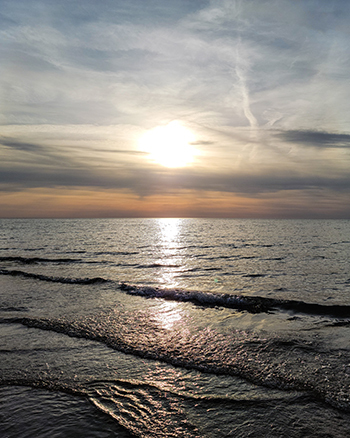
As the weather cools down and days grow shorter, the Michigan Department of Natural Resources wants state park visitors to be aware that staff is starting to remove swim buoys, beach warning flags and other visual markers that denote designated swim beaches at state parks along the Great Lakes.
As these buoys and flags are removed from a stretch of beach, that location is no longer operated as a designated swim beach. That means swimming is not recommended there, but the beach is still open to the public. Swimmers should use the same caution entering the water there as they would any other nondesignated swim beach along the Great Lakes.
Beachgoers have come to rely on the various safety measures and visual cautions that are put in place at designated swim beaches in the summer months. These include buoys or buoys and markers that identify the boundaries of a designated swimming area with water depth less than 5 feet (inspected approximately every two weeks), a beach flag warning system, safety signage and rescue equipment.
These amenities are typically installed before the Memorial Day holiday weekend and come down after Labor Day. On-shore rescue equipment will remain along the shoreline for as long as weather allows, typically through late September or early October.
"The reason the buoys and beach flag warning system are taken down after the Labor Day Weekend is because the weather patterns begin to change in September," said Pat Whalen, Plainwell District supervisor for the DNR Parks and Recreation Division. "September can be unpredictable in terms of high winds and waves and water temperatures, which can often prevent staff from 14-day inspections and removal of the swim buoys."
Whalen also emphasized that there are several hazards that can exist in the water, such as strong longshore currents, rip currents and submerged objects.
A few other cautions:
- There are no beach guards at state parks, so never swim alone, always keep close watch of children and bring U.S. Coast Guard-approved life jackets, especially for new and inexperienced swimmers.
- Water currents near piers, breakwalls and outlets of rivers can be extremely hazardous.
- Weather patterns, especially in the fall months, can change quickly. Check local weather reports and lake conditions and learn about different Great Lakes currents and how to escape them.
- As the Great Lakes water temperatures drop, monitor swimmers for cold water exposure which can result in hypothermia. Water temperatures can change radically in 24 hours.
Visit Michigan.gov/BeachSafety for tips and information on safely visiting the Great Lakes, including state-designated swim beach locations, the beach flag warning system, Great Lakes currents (and how to escape them) and more.
For more information, contact the DNR's Pat Whalen at 269-838-1196 or [email protected].
|